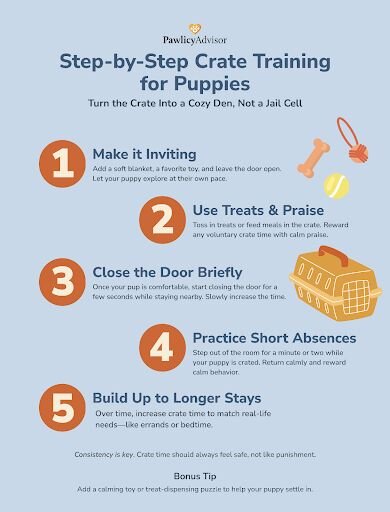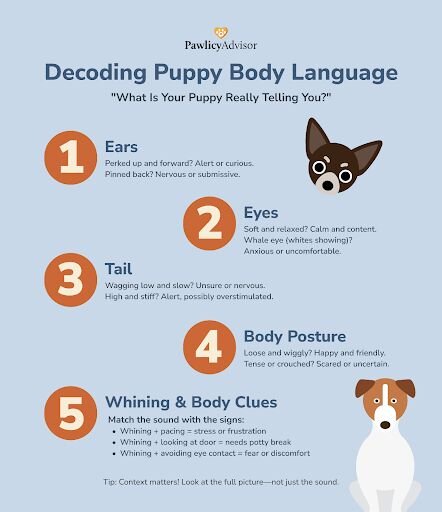How to Stop Puppy Whining: Vet-Approved Advice
Does your puppy whine all the time, leaving you wondering why? You’re not alone. Whining is a common puppy behavior, but the right approach can help your pup feel secure and happy.
Key Takeaways
- Puppy whining is common, but you can address it with patience and the right approach.
- Understanding why your puppy whines and using positive reinforcement can help them feel secure.
- If the whining continues despite intervention, or you suspect a health issue, consult your veterinarian.
- As your puppy grows, pet insurance can help manage unexpected care costs.
Your new puppy may be small — but their vet bills might not be.
Save big on costs with pet insurance, so you can protect your puppy while protecting your wallet.
This guide explores why puppies whine and how to train them to stop. Our expert-backed insights will help you identify the root cause, whether it’s separation anxiety, attention-seeking, or other factors.
Let’s help your puppy—and you—get some peace and quiet!
✔️ Reviewed by multiple licensed veterinarians
✔️ Updated with the latest medical data
✔️ Compiled from veterinary research
Why is my puppy whining?
Puppies whine to express needs like hunger, attention, fear, or discomfort. It’s their way of communicating, especially when they're adjusting to a new environment.
Understanding puppy communication
Whining is a natural form of communication for your puppy. It’s how they express themselves and get your attention to fulfill a need, similar to why babies cry.
Although some whining is normal, excessive or persistent whining could signal a deeper issue. Understanding the context of puppy whining is key.
- Whining vs. barking: Puppies may bark for attention, to alert you to a perceived threat, or out of excitement, while whining expresses a need, such as hunger, discomfort, or separation anxiety.
Common reasons for whining
Puppies whine for several reasons, some more common than others. In a Forbes Advisor survey of 2,000 dog owners, one in four (24%) cited barking or whining as the biggest challenge of owning a dog, highlighting just how common this frustrating behavior can be.1
Understanding what causes whining will guide your approach to resolving it. Common causes include:
- Attention-seeking behavior: Puppies may whine to get attention from you, especially when they want to be held, played with, or simply noticed.
- Hunger or thirst: A puppy may whine when they’re hungry or thirsty, especially if they haven’t had a meal or drink in a while.
- Need for bathroom breaks: Puppies often whine when they need to go outside. Keeping a consistent potty schedule can help.
- Separation anxiety: Many puppies experience separation anxiety, causing them to whimper when left alone, as they crave the comfort of their owners. You may notice this behavior when you leave the house or put your puppy in a crate.
- Fear, stress, or discomfort: Loud noises, unfamiliar environments, or physical discomfort (e.g., being too hot or cold) can make puppies whine.
- Medical issues: Whining can be a sign of illness or pain. If the whining seems unusual or persistent, consult a vet.

How to stop a puppy from whining
What NOT to do
You may be tempted to respond immediately when your puppy whines, but it's important to avoid reinforcing the behavior. Here’s what not to do when addressing puppy whining:
- Don’t reinforce whining: If you reward your puppy with attention, food, or toys when they whine, they’ll learn to use whining to get what they want.2
- Don’t yell or punish: Yelling at or punishing your puppy can increase anxiety and worsen whining. Instead, stay calm and address the root cause of the behavior.
- Don’t ignore context: It’s essential to recognize the difference between whining that indicates a temporary need (e.g., bathroom breaks) and whining that occurs out of habit or anxiety.
Positive reinforcement training
The key to training your puppy is positive reinforcement. This training style involves rewarding calm behavior and using praise or treats as motivation.
- Reward-based training: When your puppy stops whining or exhibits calm behavior, reward them with a treat or verbal praise to reinforce the desired behavior.
- Teaching calm behavior: Reward your puppy when they remain calm in situations that typically trigger whining (e.g., when you leave the room or during crate training).
Establishing a consistent routine
Puppies thrive on routine, which helps them feel secure and makes them less likely to whine. Here are a few tips to establish a routine:
- Set feeding and potty training schedules: Regular feeding times and bathroom breaks can prevent whining due to hunger or needing to go outside.
- Crate train your puppy: Crate training helps establish a safe and secure space for your puppy, preventing whining due to fear or anxiety. Gradually increase your puppy’s time in the crate to help them get used to it.
Using the right tools and resources
Several tools can help you manage your puppy’s whining behaviors, including:
- Chew toys and calming aids: Items like chew toys, puzzle feeders, and calming collars can help distract your puppy, prevent boredom, and reduce stress.
- Training classes and professional guidance: If you’re struggling to manage your puppy’s whining, enrolling in a puppy training class or seeking a professional trainer’s advice can offer support.
Addressing specific causes
Every puppy is different, so it’s important to tailor your approach to puppy whining based on the root cause of the problem. Examples of ways to address whining include:
- Providing routine and structure: Consistency and structure help puppies feel more secure.
- Socializing your puppy: Gradually exposing your puppy to different environments, people, and dogs helps build confidence and reduce anxiety.
- Reducing separation anxiety: If your puppy is particularly clingy, try leaving them in a separate room for short periods and gradually increasing the time they spend alone to help them adjust.
- Ensuring physical and mental stimulation: Ensure your puppy gets enough exercise and mental stimulation, which can reduce whining related to boredom.

When should you be concerned about whining in puppies?
"While occasional whining is normal, excessive or sudden whining could indicate a deeper issue,” said Dr. Angela Beal, DVM, FFCP. “Many pet owners assume whining is always behavioral, but it can signal pain, digestive issues, or early signs of illness. If the whining is excessive or sudden, don't ignore it—schedule a vet checkup as soon as possible.”
You should worry about your puppy’s whining if you think it could signal a bigger problem, including:
- Health issues: If your puppy’s whining is accompanied by signs of illness (e.g., lethargy, loss of appetite, or unusual behavior), it may be time to consult a veterinarian.
- Behavioral issues: If your puppy's whining doesn’t improve despite training and positive reinforcement, it could indicate deeper behavioral issues that require professional attention.
How to save on unexpected vet costs
Unexpected vet bills can add up for a new puppy owner. Consider investing in pet insurance to help cover unexpected medical costs throughout your puppy’s life. Learn more about how pet insurance can protect your pet’s health and your wallet.
Looking to save on vet bills? See if pet insurance is right for you.
Instant results. No spam. 1M+ pet parents served.
Frequently asked questions about puppy whining
Is it normal for puppies to whine a lot?
While it’s normal for puppies to whine as a form of communication, excessive whining may indicate a need for attention or training.
What does it mean when a puppy whines?
Whining has several potential meanings, including that your puppy is hungry, bored, fearful, anxious, or needs to potty.
How do I know if my puppy’s whining is a sign of distress?
If the whining is persistent and accompanied by other signs, such as hiding, pacing, or lack of appetite, it may be a sign of distress or illness.
Does crate training help reduce whining?
Crate training helps puppies feel secure in their own space, which can reduce separation anxiety. If your puppy whines in the crate, gradual training and positive reinforcement can make the experience more comfortable for them.
How long should I let my puppy whine before responding?
It depends on the situation. If your puppy whines for attention, it’s best to ignore them until they stop. If they might need a bathroom break, respond promptly.
When should I take my puppy to the vet for whining?
If your puppy’s whining seems excessive, persistent, or is accompanied by signs of distress, such as lethargy, loss of appetite, or behavior changes, consult a veterinarian.
Whining can sometimes indicate an underlying medical issue, such as pain or illness. When in doubt, take your puppy to the vet. A veterinarian can help rule out health concerns and provide additional advice on addressing the whining behavior appropriately.
Do you want to find the best pet insurance?
Let's analyze your pet's breed, age, and location to find the right coverage and the best savings. Ready?
Analyze My PetAbout Pawlicy Advisor
The pet insurance marketplace endorsed by veterinarians, at Pawlicy Advisor we make buying the best pet insurance easier. By comparing personalized coverage and pricing differences we can save you a ton of money, up to 83% in some instances!
Instantly Compare Pet Insurance Plans
Guides
Determine If Pet Insurance Is Worth It
Comparison Charts
Find Your State
Dog Insurance
DVM, FFCP
Dr. Angela Beal has worked in private practice and taught veterinary technicians for 15 years. Angela is a veterinarian who loves using her writing to help pet owners provide the best possible care for their furry companions. Since 2020, she has worked full-time within the veterinary education writing and editing industry. Angela lives in Columbus, Ohio with her husband, two sons, and their spoiled Chihuahua mix, Yogi.
